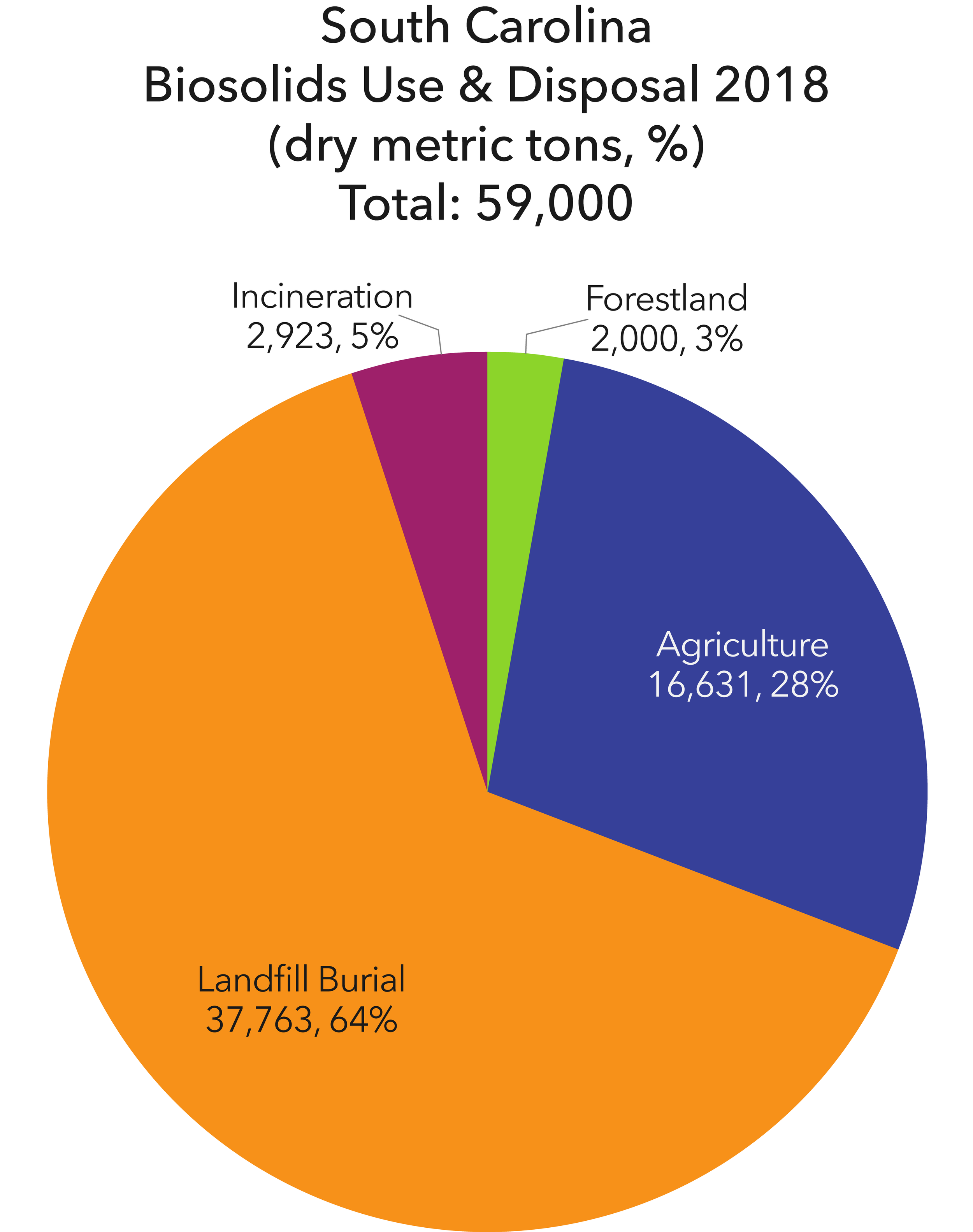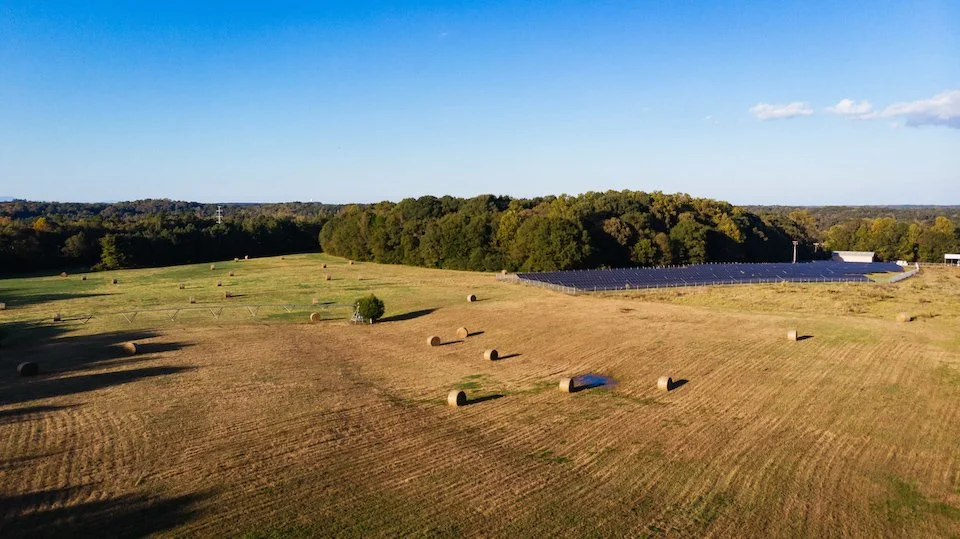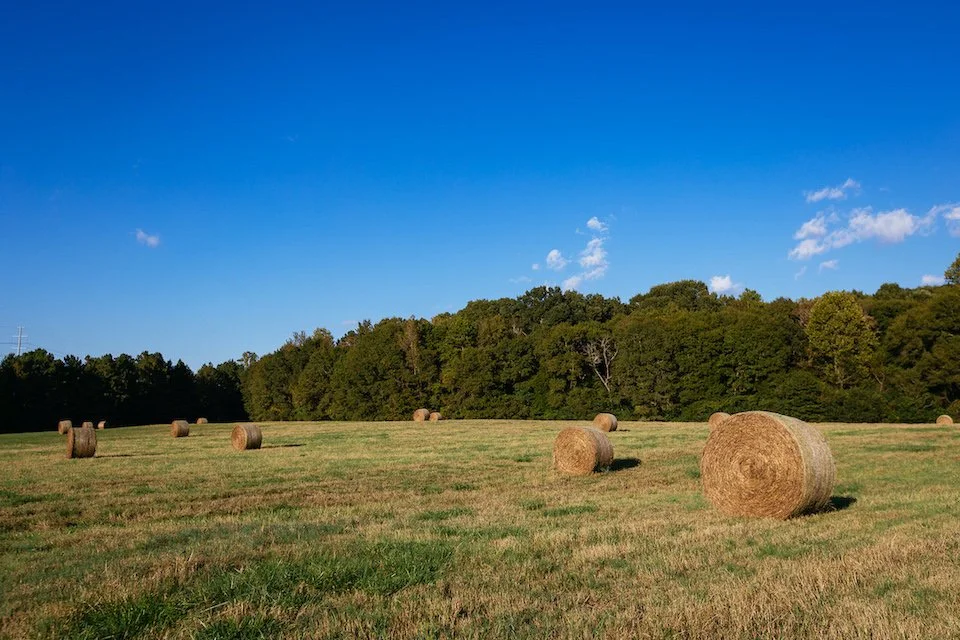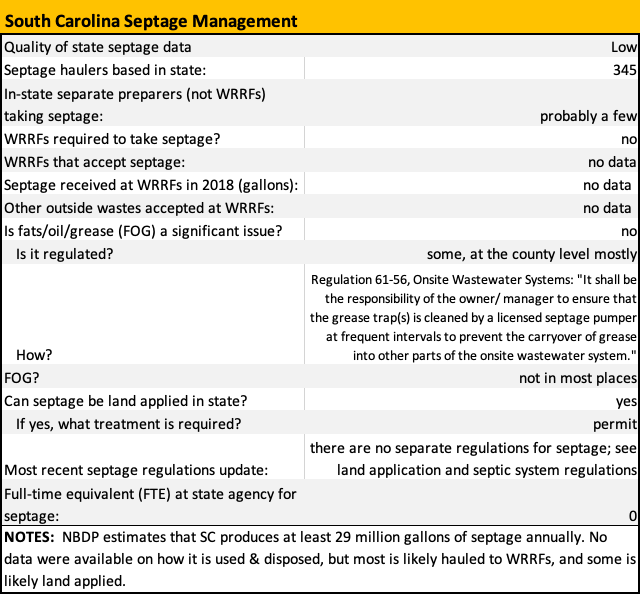State Data
Confidence in data for this state:
MODERATE
2018 data unless noted.
Definitions
Terms used on this website and in data sets are defined & discussed here.
Land application site for ReWa’s Durbin Creek WRRF’s biosolids. Photo courtesy of ReWa.
Hay grown with biosolids from ReWa’s Durbin Creek WRRF. Photo courtesy of ReWa.
Landfill. Photo courtesy of US EPA.
State Statistics Dashboard
State Summary
● About 2/3rds of South Carolina wastewater solids were landfilled in 2018, including >80% of the solids from Charleston (the rest was land applied), and all of the solids from North Charleston, Columbia, Mount Pleasant, Summerville, Goose Creek, Hilton Head, Florence, and Spartanburg, which has 8 water resource recovery facilities (WRRFs), treating an average of ~15 million gallons per day (MGD) of wastewater, the largest being the A. Manning Lynch facility at ~12 MGD.
● About 5% of SC solids went to incineration in 2018: Rock Hill sent nearly 3,000 dry metric tons (dmt) to the sewage sludge incinerator (SSI) in Concord, NC, owned and operated by the Water & Sewer Authority of Cabarrus County. Lancaster Co. also sent some solids to that SSI.
● The rest of SC’s wastewater solids are treated and land applied – from about 30 water resource recovery facilities (WRRFs), mostly the larger WRRFs, sometimes with the contracted help of land application companies such as Synagro or Bionomics (based in NC).
o ReWa (Greenville), population ~68,000, has 7 WRRFs treating a combined 43.55 MGD, serving the metro region of ~514,600. ReWa has a nationally-recognized biosolids program, with ~7,800 permitted acres. In 2018, they applied most of their anaerobically-digested Class B biosolids to 3,526 acres of farmland, fertilizing grass for animal feed. Some of their biosolids were landfilled. That year, ReWa took in 2,663,401, 3,273,600, and 3,052,870 gallons of septage, landfill leachate, and fats/oils/grease (FOG) respectively, providing another important service to the wider community by handling these challenging liquid organic wastes.
o Grand Strand Water and Sewer Authority, serving several eastern SC communities, including Myrtle Beach, has 12 WRRFs ranging in size from .135 to 22.5 MGD capacity. The Authority composts all the combined wastewater solids in a facility located in Conway, SC. Much of the compost (as well as treated effluent) is used on two tree farms and a turf farm owned by the utility. Some is used on private farms in the area.
o Sumter produces a Class A pelletized fertilizer that is sold to a fertilizer company for marketing and distribution, with no site permits needed if <1 metric ton and no repeated application to sites. Most is used in agriculture in Florida.
o Importantly, Charlotte, NC, has ~10,000 acres permitted for biosolids in SC, and much of their biosolids are applied in SC – but those biosolids are not counted in the SC data or this report.
● The SC Department of Health and Environmental Control (SC DHEC) Bureau of Water regulates wastewater solids through NPDES permits and state regulations (R.61-9.503), which largely follow the U.S. EPA Part 503 regulations. “Land application of effluent from wastewater treatment facilities began in South Carolina in the early 1970s. Over the years the program evolved to include the permitting of sludge and septage land application…. the Land Application Permit Program addresses land application of wastewater treatment plant effluent, non-hazardous sludge, and septage…. If a wastewater facility that generates waste sludge discharges to surface waters, the method of sludge disposal or use is normally addressed in the NPDES permit rather than a separate Land Application Permit. Facilities that land apply both their effluent and sludge are normally issued one Land Application Permit for both activities” (https://scdhec.gov/land-application-permit-program). Requirements for land application that go above and beyond the U.S. EPA 40 CFR Part 503 regulations include:
o setbacks and groundwater protections
o actions to control odors (nuisance restrictions)
o sampling and testing of Class A biosolids for presence of pathogens if three weeks have elapsed since processing
o odor abatement regulations that require an odor issue plan (applicable to WRRFs and land application sites – DHEC can stop activity if there are issues
o site approval for Class A EQ land application if more than 1 metric ton is applied regularly on a site; product must be demonstrated Class A at time of application
o independent inspections of land application sites – the SC DHEC biosolids coordinator notes that inspections are done at the same time as permit compliance inspections at WRRFs. Inspections also occur if complaints are received or if a new site is to be permitted; EPA also does some site inspections.
● While in 2018 biosolids use and disposal remained steady, as it had been in recent years, in 2021 increasing landfill costs are helping drive interest in more beneficial use, according to SC DHEC. The state is meeting with stakeholders to help streamline compost regulations, and an updated permit is under review for one potential separate preparer – Williamsburg Recycling – to compost wastewater solids, as it has in the past. Class B biosolids is of less interest, because compost end uses are more flexible. SC DHEC’s main concern around composting is malodors. The new proposed regulations will have Class A EQ compost be unregulated in its end use, if approved by Clemson Cooperative Extension.
● According SC DHEC staff, challenges in biosolids management in SC include rising costs and odors – common issues everywhere. An unusual challenge that affected the Carolinas in the 2010s was illegal PCB dumping into sewers, which severely impacted three SC biosolids programs (ReWa, Spartanburg, Lyman), requiring shipping of contaminated solids to costly hazardous waste landfills. In 2021, regarding its land application program, ReWa noted: “Unknown future regulatory restraints on land application, increased wet weather conditions, increased constraints for landfill disposal, and challenges with intermediary management strategies between implementing long term management solutions – are all high pressure drivers for ReWa's land application program.” Nonetheless, SC DHEC staff note that biosolids beneficial use is slowly increasing in SC in the early 2020s.





